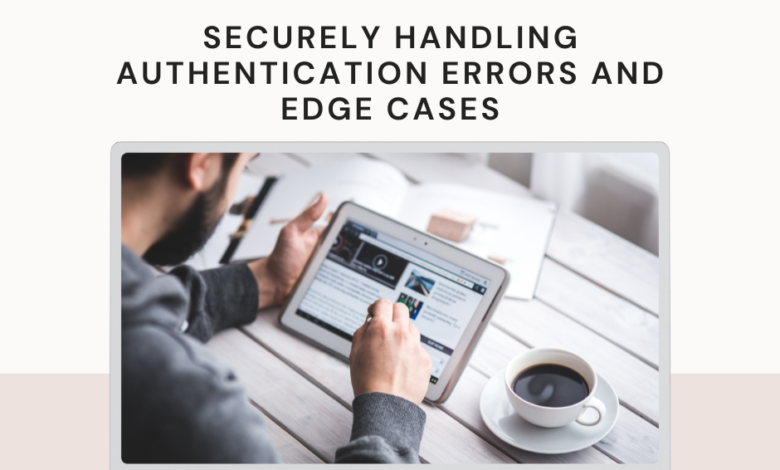Securely Handling Authentication Errors and Edge Cases

In modern web development, securely handling authentication errors and edge cases is essential for ensuring the integrity and security of applications. Authentication errors can arise due to various factors, such as incorrect credentials, expired sessions, or account lockouts. These errors not only impact the user experience but also pose security risks if not handled properly. Additionally, edge cases in authentication present unique challenges that developers must address to safeguard user data and prevent unauthorized access.
An effective approach to handling authentication errors and edge cases involves implementing robust error handling mechanisms, anticipating potential issues, and adhering to best practices in web security. This includes providing informative error messages to guide users, implementing measures to prevent brute-force attacks, and integrating secure session management techniques.
Furthermore, developers must consider edge cases such as multi-factor authentication challenges, third-party authentication provider integrations, and user consent management. By addressing these scenarios comprehensively, developers can enhance the security and usability of authentication systems.
Common Authentication Errors
1. Incorrect Credentials:
– Incorrect username or password entries are one of the most common authentication errors users encounter.
– To handle this, applications should provide clear error messages indicating which credentials were incorrect without disclosing sensitive information.
– Additionally, implementing account lockout mechanisms after multiple failed login attempts can prevent brute-force attacks.
2. Expired Sessions:
– Sessions typically have a limited duration to enhance security, but users may encounter errors when attempting to access expired sessions.
– To address this, applications should implement session timeout warnings to alert users before their session expires and provide options to re-authenticate or extend the session.
– Clear messaging and intuitive user interfaces can help users understand why their session expired and how to proceed securely.
Edge Cases in Authentication
1. Multi-Factor Authentication (MFA):
– MFA adds an extra layer of security by requiring users to provide multiple forms of verification, such as a password and a one-time code sent to their mobile device.
– Handling edge cases in MFA involves ensuring a seamless user experience while maintaining security.
– For example, developers must consider scenarios where users may not have access to their secondary authentication method and provide alternative verification options.
2. Third-Party Authentication Providers:
– Many applications allow users to sign in using third-party authentication providers like Google, Facebook, or GitHub.
– Edge cases in third-party authentication include handling provider downtime, user consent management, and data privacy concerns.
– Developers should implement fallback mechanisms to handle provider downtime gracefully and obtain explicit user consent before accessing their information from third-party providers.
By addressing these common errors and edge cases in authentication, developers can create more robust and user-friendly authentication systems while enhancing the security of their applications.
Secure Handling of Authentication Errors
1. Error Logging and Monitoring:
– It’s crucial to log authentication errors securely to track potential security threats and system issues.
– Implementing centralized logging mechanisms allows developers to monitor and analyze authentication error patterns effectively.
– However, sensitive user data, such as passwords or authentication tokens, should never be logged to prevent data breaches.
2. Custom Error Pages:
– Providing custom error pages for authentication errors enhances user experience and helps users understand and troubleshoot issues.
– These pages should be informative yet concise, avoiding verbose technical details that could confuse users.
– Additionally, error pages should not disclose sensitive information or reveal system vulnerabilities.
3. Rate Limiting and CAPTCHA:
– To prevent brute-force attacks and account enumeration, consider implementing rate limiting mechanisms.
– Rate limiting restricts the number of authentication attempts within a specific time frame, reducing the risk of unauthorized access.
– Additionally, integrating CAPTCHA challenges for suspicious or repeated failed login attempts can further thwart automated attacks while ensuring legitimate users can still authenticate.
Error Handling Best Practices
1. Input Validation:
– Proper input validation is crucial to prevent injection attacks and other security vulnerabilities.
– Validate and sanitize all user inputs, including usernames, passwords, and authentication tokens, to mitigate the risk of injection attacks like SQL injection or cross-site scripting (XSS).
2. Secure Error Messages:
– Ensure error messages provide generic feedback without revealing sensitive information.
– Avoid disclosing specific details about why authentication failed, such as whether the username or password was incorrect, to prevent enumeration attacks.
3. Graceful Degradation:
– Implement graceful degradation strategies to handle unexpected errors or service disruptions gracefully.
– When authentication services or third-party providers are unavailable, applications should provide meaningful error messages and fallback mechanisms, such as cached credentials or alternative authentication methods.
By adhering to these best practices, developers can enhance the security and reliability of their authentication systems, ensuring users’ sensitive information remains protected while maintaining a seamless user experience.
Handling Edge Cases in Authentication
1. Multi-Factor Authentication (MFA):
– Implementing MFA adds an additional layer of security by requiring users to provide multiple forms of verification.
– Consider supporting various MFA methods such as SMS codes, email verification, authenticator apps, or biometric authentication.
– Handle edge cases like lost or stolen devices by providing backup methods for users to regain access to their accounts securely.
2. Account Recovery:
– Define robust account recovery processes to assist users in regaining access to their accounts in case of forgotten passwords or compromised accounts.
– Utilize secure verification mechanisms such as email verification, security questions, or SMS codes to validate users’ identity during the recovery process.
– Implement account lockout mechanisms to prevent abuse of the recovery process and protect against brute-force attacks.
3. Social Sign-In Integration:
– Integrating social sign-in options like OAuth or OpenID Connect can enhance user convenience and streamline the authentication process.
– Handle edge cases such as expired or revoked social tokens by implementing token refresh mechanisms or fallback authentication methods.
– Ensure proper error handling and user notification for scenarios where social sign-in providers are unavailable or experience downtime.
Continuous Security Auditing and Improvements
1. Regular Security Audits:
– Conduct regular security audits and penetration testing to identify vulnerabilities and weaknesses in the authentication system.
– Engage security professionals or third-party security firms to perform comprehensive audits and assessments of the authentication infrastructure.
2. Patch Management:
– Stay vigilant about security patches and updates for all components involved in the authentication process, including libraries, frameworks, and third-party services.
– Establish procedures for timely patch deployment to mitigate known vulnerabilities and protect against emerging threats.
3. User Education and Awareness:
– Educate users about common security risks and best practices for maintaining account security, such as using strong, unique passwords, enabling MFA, and recognizing phishing attempts.
– Provide resources and guidelines for users to report suspicious activities or security incidents promptly.
By addressing these edge cases and continuously improving authentication mechanisms through security audits and user education, developers can enhance the resilience and effectiveness of their authentication systems, ensuring the security and trustworthiness of their applications.
Conclusion
In conclusion, ensuring the security of authentication systems in full-stack development is paramount for safeguarding user data and maintaining trust in applications. By implementing robust authentication mechanisms, handling edge cases effectively, and continuously auditing and improving security measures, developers can mitigate risks and protect against unauthorized access and data breaches. Furthermore, staying updated on emerging security threats, adhering to best practices, and fostering a culture of security awareness among users are essential for maintaining the integrity of authentication processes. With diligent attention to security considerations and a commitment to ongoing improvement, developers can build resilient and secure authentication systems that instill confidence in users and uphold the reputation of their applications. Enrolling in a Full Stack Developer Training course in Delhi , Kolkata, Ludhiana, Noida, and other cities in India can provide aspiring developers with the knowledge and skills needed to design, implement, and secure authentication systems effectively, equipping them to tackle real-world challenges in full-stack development with confidence and proficiency.



